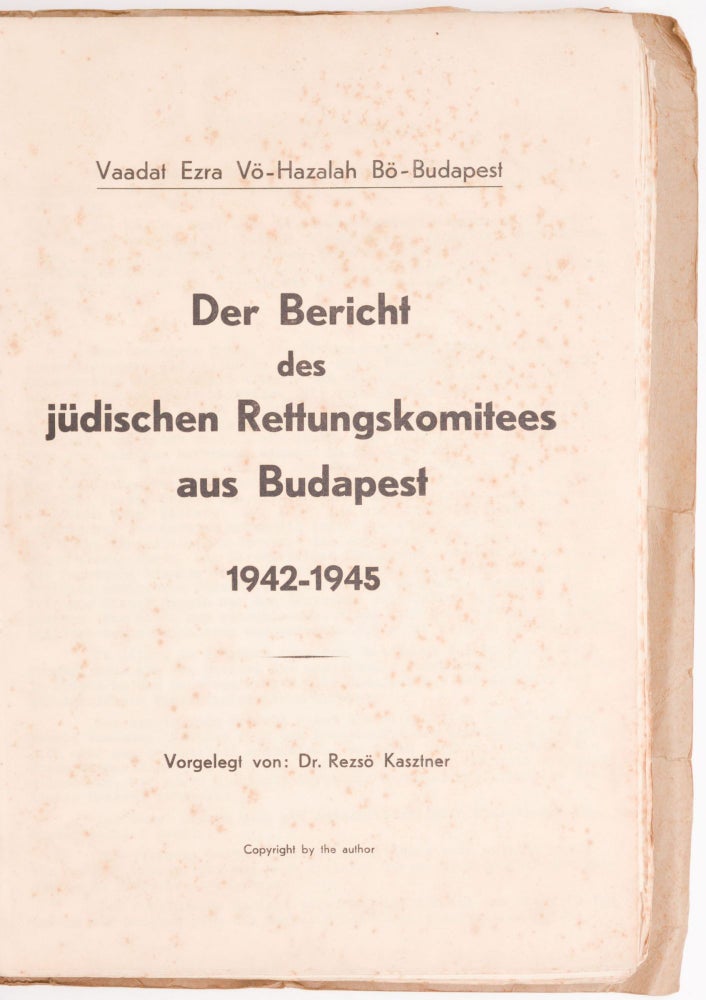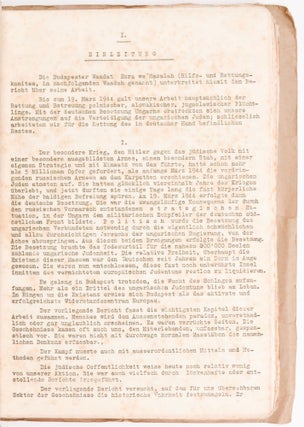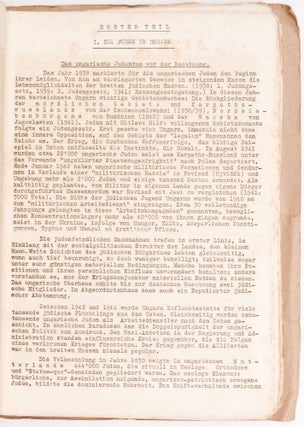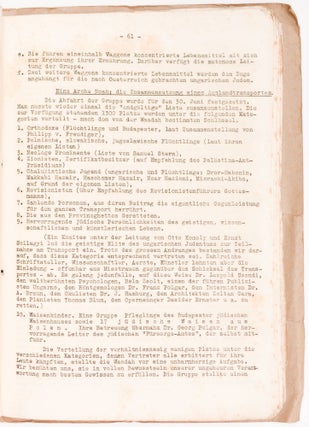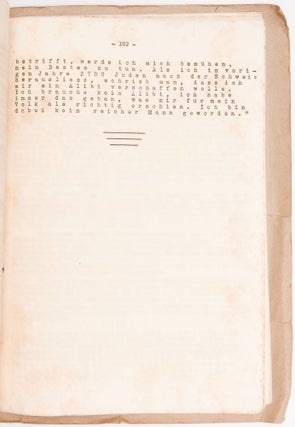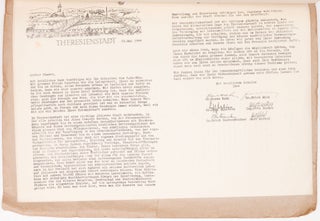Vaadat ezra vö-hazalah bö-Budapest. Der Bericht des jüdischen Rettungskomitees aus Budapest 1942–1945. Vorgelegt von: dr. Rezsö Kasztner. (Vertraulich.)
[Basel or Geneva]: Vergelegt von: Dr. Rezső Kasztner, [1946]. First edition. Mimeographed typescript. In original printed cardboard, bound with black string. ff [1] XIII [1]–15 15a 16–191 [6]. Binding chipped at edges, with small tears. Foxing throughout. All over in very good condition.
Original copy of one of the most significant documents related to the Holocaust, and probably the most important document of the Hungarian Holocaust. The report of the Budapest Jewish Rescue Committee (Va’ada), compiled by its leader, Rudolf Kastner.
Rudolf Kastner, the leader of the Zionist Rescue Committee, by negotiating with the SS in occupied Hungary, particularly with Adolf Eichmann, managed to save the life of 1,684 Jewish people, who instead of being deported to Auschwitz, in exchange for money, gold and diamonds could escape to Switzerland on 35 cattle trucks, became known as the Kastner train.
After the War, his activities were questioned, and he faced the accusations of being a collaborator of the Nazis, whose motive was to save the life of his family and friend, a traitor of the Hungarian Jewry who kept the information about the deportations back from them, thus not encouraging their escape or resistance.
To defend himself against the accusations Kastner compiled the present report and circulated it among the members of the investigative committee of his case at the Zionist Congress in Basle, in 1946 December. In thirteen sections Kastner reveals the activities of the Rescue Committee between 1942 and 1945. Kastner gives the details of the cooperation between the Budapest Relief Committee and the fellow organizations of other countries; of the rescue efforts of smuggling Jews from the neighboring countries to the then relatively safe Hungary (before the German occupation on March 19, 1944); the preparation to the self-defense of the Hungarian Jewry; and of the food and shelter operation provided by Va’ada for the Jews in Budapest under the siege. Kastner reports about their attempts to procure the support of politicians and church leaders for the Hungarian Jewry, and also about the negotiations with high ranking SS officers such as Adolf Eichmann, Kurt Becher, and Dieter Wisliceny. Through such contacts, Kastner could organize the escape of almost 1,700 Jews to Switzerland in exchange for various goods. Besides these acts, the Committee also achieved that more than 15,000 Hungarian Jews were transferred to labor camps at Strasshof, rather than being killed at Auschwitz.
The investigative committee eventually announced that “Kastner performed tremendous activities during the war for the good of the Jewish people, at the risk of his life and that of his family”.
In 1947 Kastner moved to Israel, and became a spokesman for the Ministry of Trade and Industry. His case came into the focus of interest again in 1952 after the publication of Melchior Gruenwald newsletter, wherein Kastner was accused again with behavior and actions that facilitated the destruction of Hungarian Jewry, toplevel collaboration with the Nazi Occupiers of Hungary in 1944, moreover giving his testimony in favor of the Nazi Kurt Becher. As a response to the newsletter, the Israeli government sued Gruenwald on Kastner's behalf. The judge ruled in Gruenwald’s favor, and stated that Kaster has “sold his soul to the devil”. The decision had a severe effect on Israeli politics and led to the collapse of the government. In March 1957, Kastner was assassinated and soon died of his injuries. In 1958 the Supreme Court of Israel overturned most of the former judgments, stated that the lower court had erred seriously.
Literature: Szita, Sz., Lambert, S.: Trading in lives? Operations of the Jewish Relief and Rescue Committee in Budapest, 1944–1945. Budapest; New York: Central European University Press, 2005.; Troen, S. I.; Lucas, N.: Israel. The First Decade of Independence. Albany: State University of New York Press, 1995.
.
Price: €8,000.00

